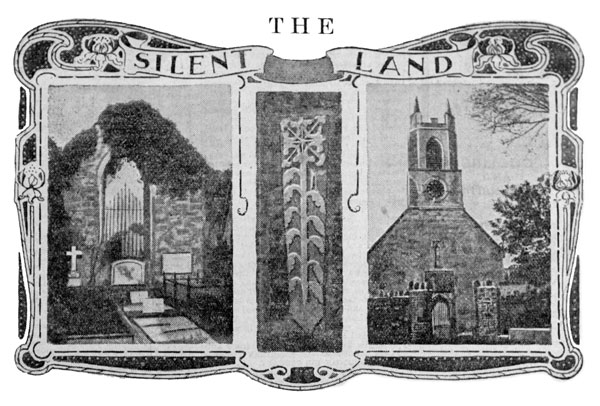Belfast Evening Telegraph, Wednesday, June 5, 1907
 |
||
| Interior of Holywood Church. The small white cross marks the burial-place of Archbishop Knox, late Primate of all Ireland. |
Lid of stone coffin recently unearthed in this cemetery. | View showing the front of the old building with the clock tower |
XVI -- Holywood Burying-Ground.
According to Dr. Alexander Knox, the Church of Haliwode, now the parish of Holywood, had the ancient name of Ardmacnissi or Sanctus Boscus, all being synonymous terms. In the year 1210, King John, on his way to Downpatrick, halted there; and although no reference is made to the actual situation of the old building, we may take it for granted that it has disappeared. At the end of the town, where the road leading to Bangor takes a sharp turn, there is the cemetery, and a wonderful little place it is. Just beyond the entrance gate will be found the walls and clock tower of an ancient edifice, which, I understand, was the parish church of Holywood, used prior to the election of the present beautiful building in another part of the town. Its existence can be traced back over many centuries, but, as may be expected, there are no stones in the graveyard to prove this statement; nevertheless, a. short time ago, one of the attendants, in making a new grave, discovered a stone coffin, and the lid or covering is at present built into the wall of the old church. The photograph published herewith will give some idea of the beauty of the carving on this curiosity, and it will be noticed that the sculptor has interrupted the continuity of the design to get in a pair of sheep shears, doubtless with some definite end in view. The effort to preserve this legacy from the past is commendable. Many of the more ancient stones in the ground are defaced by time and weather, but we are able to decipher a few, which are both interesting and quaint, and at random I pick the following from my collection:--
HERE LYETH THE BODY
OF JAMES RUSSELL OF
BALLYKEEL WHO DYED
THE 26 OF JANUARY 1715
AGED 63 YEARS.
ALSO HIS WIFE JANE
KELL WHO DYED YE
21 OF FEBRUA.RY 1744
AGED 92 YEARS.
HERE LYES THE BODY OF
JOHN RUSSELL SONN OF
WILLIAM RUSSELL OF HOLYW
OOD WHO DEPARTED THIS
LYFFE SEPT. THE IX 1670
AND OF HIS AGE 118 YEARS.
It is rather peculiar that the first to leave should find the last place on the stone, but it is to be presumed that this was an effort to preserve a record of John Russell's great age. That they are not yet forgotten is evidenced by the fact of some wreaths which are just beginning to decay still lying on the stone. The slab is flat, and supported by four short granite columns. A student in fashion of tombstone's at different periods would find plenty of room for study here, as the variety is wonderful. But whatever difference there may have been in the style of the memorial, it is certaIn that there is no graveyard hereabouts where there is such unanimity as to the epitaphs, for most of the tablets contain exhaustive biographies of those whose bodies lie below. This is not confined to any particular period. Here is an ancient one:--
JAMES HAMELTOVN LYES UNDER
THIS STONE BELOVED OF ALL AND
HATED OF NON FROM MORT
AL LIFE WHO DEPARTED
THIS LIFE THE TWENTIETH OF
DECEMBER 1691.
Others share the slab, but as a contrast here is a modern conception:--
To the
Memory of
James Kennedy Jackson
of Belfast
Solicitor, Deputy Clerk of the Crown,
Coroner, etc.
In commemoration of his
Consistent Honourable bearing
throughout life as a perfect
Gentleman and Friend
Eminently honoured and esteemed
in his profession and in the
Discharge of his official duties
He was especially endeared
to his relatives and friends
By his most cordial and
genial disposition
Of the utmost amiability and
Kindness of Heart
Of Sterling Character
Of Rare Wit and Accomplishments
He will by all who through relationship or friendship
were associated with him
Be ever held
In most affectionate remembrance.
Died 20 July 1865 aged 61 years.
There are quite a number of stones recording deaths late in the seventeenth and early in the eighteenth century, and it is remarkable to find how many clergymen of different denominations have been buried here. Against the walls of the church there is a blue slate, but as it does not cover a grave it has probably been removed from another part of the ground. It bears this inscription:--
Here lie interred
The remains of
The Revd. James Hamilton
late of Mount Collyer
who departed this life on
the 18th of Novr. 1796
Aged 74 years.
-- -- -- -- -- --
In him were the ineftimable
qualities of Piety, Benevolence
and Humility so eminently
united as endeared him
to all Ranks in Society
in Converfation he was pleafing
and inftructive nor cou'd
his generous and enlightened
mind dictate an exprefsion
to wound the feelings of
a. Fellow Creature
Truth and equity were the
Standard of his every act.
While admiring the composition of this eulogy it is impossible to overlook the vagaries of the sculptor. In the word "cou'd" an apostrophe is used, but, as it occupies as much space as the letter it was supposed to represent, it is difficult to understand why it was put in at all.
The ground is covered with memorials which are full of local interest. There are the Bruces of Thorndale, the Blakiston-Houstons, the Robertsons, and on a black railing which encloses a modest plot hangs a shield which announces that this is the burying place of Henry Joy M'Cracken, doubtless some friend of the famous United lrishman. There is a slab in memory of James Palsell Esq., Tide Surveyor of Holywood, who died in 1906. But there is one other inscription which, although rather lengthy, I feel justified in recording as a unique sample of what can be done in this line. I mIght say that, as far as I could see, no date or age was gIven:--
Beneath this stone lies intered
what was mortal in
-- -- -- -- -- --
who died the death of the righteous
having lived the life of the just
Even by faith in the Son of God
who suffered and gave himself for her
As the hands upon the dial
by the regularity of the movements
show the excellency and uses
of the mechanism within
so the virtues of her life
proclaimed to all who know her
the purity and brightness
of that never dying principle
Her piety was rational and fervent
Her benevolence ample and unwearied
and both were practised
with the meekness of charity
with the singleness of eye
and sincerity of heart.
-- -- -- -- -- --
Pause reader for a moment
To acquire or hold fast this lesson
more important to your happiness
than all the measures of human knowledge
that the faith which made her lovely in time
and constitutes her bliss in eternity
may this divine grace be yours
and adorn you also with a crown of
immortality.
It is peculiar that Holywood, having been a garrIson town for so long, few military men arc buried here. "Those who go down to the sea in ships" are represented, and one inscription is particularly pathetic;-- "Sacred to the memory of Captn. Richard Bell of the Pomona of Workington, who with two of his crew was unfortunately drowned at Belfast Lough on the 20th of December 1803, who after laying 14 weeks in the water was intered near this place. Aged 26 years."
About seventy years ago permission was given to bury inside the walls of the old church, and there are quite a number of important personages interred here. In a quiet corner a modest little white marble cross, decorated with a bishop's mitre and the letters "'R.A.," marks the burial place of Bishop Knox, Archbishop of Armagh and Primate of All Ireland. The photograph given here shows the spot. Other tablets are erected to members of the family and to some of the Fitzgibbons, from among whom the grand old Churchman chose his wife. His companions in this sacred enclosure have been all more or less famous in their way. There is the Rev. H. E. Cantwell, at one time vicar of the parish; Professor Sullivan, the founder of the Sullivan Schools, and for upwards of 36 years officially connected with the Board of National Education in Ireland; George Lillie Craith, for 17 years Professor of History and English Literature in Queen's College, belfast; and several others.
This little place is well known, but it is certain that few of those who scamper past on cycle and motor ever think of the treasures it contains. Just outside the wall, in a separate enclosure, is a monument to the memory of two young men drowned through the capsizing of a yacht in the Lough close by; and, as the sun was setting, I could not resist the temptation to carry away with me a picture of the quaint old tower which will be familiar to the thousands who travel by this road.

